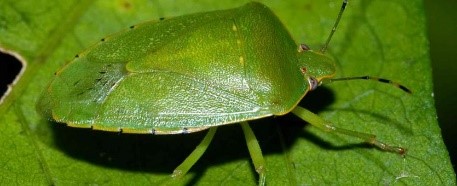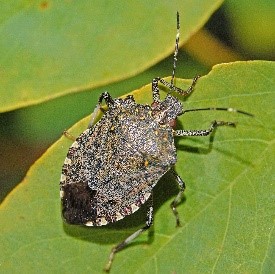Stink Bugs- is this another plague? Just a change in the season.
It sure seems like we’re in the midst of yet another plague of obnoxious pests, and this one invades houses! Thankfully, it is not a plague, unfortunately, it’s a yearly occurrence when we reach the Fall season.
There are several species of stink bugs that survive in southern Indiana incl

budding the Green stink bug. It seems like in recent years, we have seen an increase in the number of stink bugs that invade our houses around September. This is most likely due to an increase in the invasive stink bug species, Brown Marmorated stink bug. To reduce their numbers, it’s important to understand their habits and food sources.

Stink bugs reproduce and eat all summer, sucking plant juices from vegetation like berries, young trees, corn, alfalfa, and wheat then laying their eggs on the underneath side of leaves. They start their hibernation process around September, looking for warm, humid locations… like our homes. Luckily, the stink bug does not structurally damage houses like termites, but they do get their name from the smell that resonates if they are stressed or squished.
So, how do they enter our houses? Like many other pests, they look for cracks and holes around doors and windows, in screens, eaves, vents and air conditioners. Pretty much anywhere they will fit. You’ll notice them mostly on walls, in curtains, or in crevices and corners with little attention. It goes to say; your first line of defense is to check these points of entry and seal any holes and cracks you find. Other control methods include: removing food sources like open containers or leafy vegetables on the counter. Outside the house, clean up and cultivate your garden, removing wilted and dead plants which harbor hibernating insects and unhatched eggs. Clean up weeds and plant clutter in landscaping, especially around the house. Inside, vacuum often and remove the bag or empty the container outside. As we said before, they get their name due to the smell that’s given off if squashed, so it is probably not in your best interest to use this tactic. On plants, simply spraying off the bugs, physically can help reduce plant feedings and eggs laid. Adding a bit of dish soap can help by dehydrating the exoskeleton of the stink bug.
If you are interested in essential oils, mint and lavender oils can be deterrents. Neem oil sprayed on house plants can help keep stink bugs from returning. Sacrifice plantings away from gardens and house landscapes can help by drawing the bugs to them and away from your residence. They are attracted to plants like yellow sunflower, mustard, millet, and garlic.
If you have an extreme invasion inside your house, it is best to contact a pest control company to help with massive number of pests. If you have other questions about stink bugs or other fall gardening tips, please contact the Purdue Extension Office of Harrison County at 812-738-4236 or medge@purdue.edu. Reference articles from pest.org and pestworld.org
